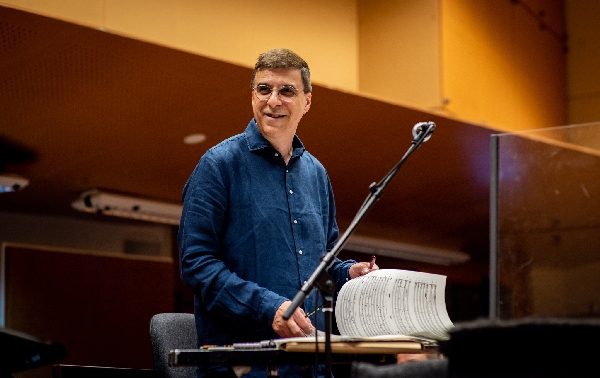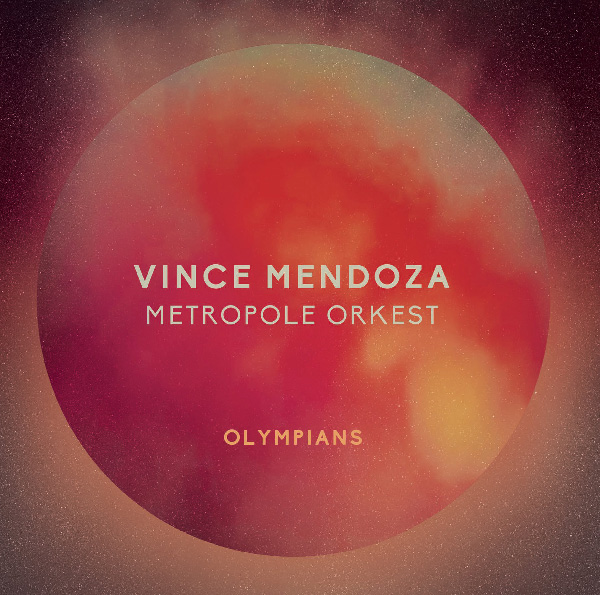| Columns Retired Columns & Blogs |
Olympians and Night on Earth: something new and something old. Thanks for a great read.

Audio engineers never get the credit they deserve. The same is true for music arrangers, who are also an unheralded but hugely fundamental part of any musical success. As a composer, conductor, and inventive arranger of popular music, the modest but multitalented Vince Mendoza says he's most focused on enhancing the song he is arranging and the story it is trying to tell.
"Young arrangers are very concerned with their own voice and spinning their own melodies and turning things upside down and backwards, and they forget what a song really is about," he told me in a recent Zoom conversation from his home in Los Angeles. "You could be writing about heartbreak, and there are a million and one ways to tell that story, but the listener still has to feel it.
"Shapes, rhythm, color density, and form—all of those elements enter into what I am trying to say and what I need to use to say it," Mendoza said. "I am open to any kind of instrumentation, any kind of color I can use that might tell the story differently than I have in the past.
"Arranging has given me the opportunity to walk into so many different styles, work with a lot of different artists, and contribute to so many wonderful songs and stories that I would not have otherwise done. It has enriched my life as a musician and probably my decisions as a composer."
In his extraordinarily varied and accomplished career, one in which he's won eight Grammy Awards, most for arranging, Mendoza has often been at his best as arranger, conductor, and composer at helping women tell their stories. He made his biggest splash in the music world when he served as arranger and conductor for Björk's Selmasongs (2000) and Vespertine (2001) and Joni Mitchell's Both Sides Now (2000) and Travelogue (2002).

A recording artist in his own right, Mendoza's new orchestral album, Olympians, features several guest artists, including vocalists Dianne Reeves and Cécile McLorin Salvant. In his upcoming composing, arranging, and recording project Constant Renaissance, a legendary female artist is at the heart of the three-movement classical/ jazz hybrid. A commission from the music school at Temple University in Philadelphia, this cinematic work tells the story of three luminaries from the city's proud jazz history: Billie Holiday, Dizzy Gillespie, and John Coltrane. The middle section, titled "Solace and Inspiration," is inspired by the immortal Holiday and captures in original sound some of the pain, love, and longing that continue to make her such a transcendent artist. Mendoza's connection to Philly runs deep, both musically and in terms of arranging, as he enthusiastically confirmed in our conversation: "The music of Philadelphia soul artists, Thom Bell in particular, and Gamble and Huff, made me really want to be a musician. And to hear French horns with a rhythm section and glockenspiel!"
In our Zoom call, Mendoza smiled and asked if I had an agenda when probing his affinity for female artists. He admitted that many of the most notable projects of his career have come via collaborations with women, but he attributes that more to happenstance than to any deep-seated certainty on his part that women tell better stories: "It's not so much about the gender of the vocalists but the songs and the songwriters."
In Mendoza's career, few songwriters have meant as much as the recently departed Burt Bacharach: "For me the Burt stuff is the history of my life. I grew up listening to the radio."
As the chief conductor of Metropole Orkest in the Netherlands from 2005 to 2013, Mendoza made a series of albums on Blue Note Records (which, alas, were not released in the US) that focused on Bacharach's songs with Dutch singer Trijntje Oosterhuis. A high-gloss live production in the Orkest's home base of Hilversum, Netherlands, became a concert film. The Bacharach-Oosterhuis albums were engineered by the late Al Schmitt, a much-respected audio legend who recorded albums by Frank Sinatra, Jefferson Airplane, Michael Jackson, Neil Young, Bob Dylan, and many others (footnote 1). Mendoza says he learned "so much" about recording from watching Schmitt work and hearing the results. One Mendoza composing/arranging specialty that Schmitt's recording took to a higher level is the integration of a rhythm section (drums, electric bass, acoustic piano) with a full horns-and-strings orchestra.
"I'm definitely picky about sound," Mendoza tells me. "If there isn't a connection between the sound of the rhythm section and the orchestra, then the music I write doesn't make sense. It's a challenge because when the rhythm section is stuck in the middle of the orchestra, you're really at the mercy of either the P.A. mixer or it just turns out to be a mess. With recording, I want to wrestle that challenge of having the air of a proper orchestral sound but the power of a rhythm section.
"In order to do that with the Bacharach music, we had separate rooms. Al was a proponent of getting it all down on the spot. He was very much anti-EQ and compression. He wanted to handle it with microphones, where he puts them and how many he used. He was also focused on where the players are going musically and what the instruments actually sound like when you're standing in front of them. When we went to mix and put up the faders, everything sounded amazing, and there wasn't that much to do because I was balancing the orchestra from the podium, and it was also being recorded in this very natural way.
"It's all a learning laboratory, every project. You learn what you like and don't like, what works and what doesn't. From the soft beginning of a piece to its loudest moments is what I am interested in. The more that I write, the more I am interested in using the dynamic range of an orchestra."

Olympians and Night on Earth: something new and something old. Thanks for a great read.

The first time I saw an LP record label with a credit for the "arranger" I thought it was a reference to a person who determined the order in which the songs appeared on the album. I was thirteen. I still wince when I think about it.

This is a home run of a CD. Thanks for the heads-up on this one. The three-fold card stock tray is stocked full of goodies to know about this group.
The arrangements are 1st class and great fun, the recording is a 5 out of 5, and the orchestra layout on the stage you can see, once you remove the CD, only shows how many great musicians you can put on one stage and still sound like one-cohesive unit, beginning to end.
This had to be somewhat of an engineering nightmare given the size of the stage and the number of musicians, but they met the challenge.
This has to be a record to live for choice I would think. I cannot wait to hear is 2011 offering of Night On Earth.
NOT TO BE MISSED.

I loved Olympians so much I bought his 2011 "Nights On Earth" and loved it just as much. The recording is great and is a good system test dics.